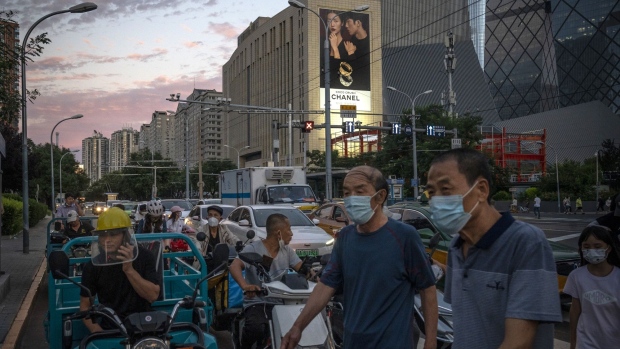Aug 15, 2022
China’s Growth Seen Weakening in Months Ahead, Economists Say
, Bloomberg News

(Bloomberg) -- Sign up for the New Economy Daily newsletter, follow us @economics and subscribe to our podcast.
China’s economy could weaken even further this year after July data showed the recovery slowing down and as a housing market downturn and Covid-related disruptions continue taking their toll.
That’s according to economists, some of whom cut their gross domestic product growth forecasts after Beijing released new economic figures Monday and as the People’s Bank of China surprisingly lowered its key interest rates. ING Groep NV and TD Securities Inc downgraded their full-year GDP forecasts to 4% and 2.9%, respectively, while Nomura Holdings Inc. -- which projects a 3.3% expansion -- said the market is still “too optimistic about growth.”
Here’s what economists are saying about China’s growth prospects:
Ding Shuang, chief economist for Greater China & North Asia at Standard Chartered Plc
“We see significant downside risk to our forecast,” Ding said. “Some leading indicators for August suggest the economy may be even worse than July due to the Covid resurgence.” Standard Chartered currently forecasts full-year growth of 4.1%. The median estimate of economists polled by Bloomberg is 3.8%.
“The interest rate cut will have some marginal benefit, but China will need to improve the Covid policy and significantly change the property policies in order to turn around the weak momentum,” he said, adding that “the key problem is there’s no confidence in property developers, on whether they can survive and deliver projects.”
The PBOC may cut policy interest rates by another 10 basis points by the end of October if other types of policy easing don’t come, while the reserve requirement ratio will likely be kept unchanged because liquidity is still ample, according to Ding.
Helen Qiao, chief economist for Greater China at Bank of America Corp
The data “showed that domestic demand is currently pretty weak, and it does warrant more policy easing,” Qiao said in an interview on Bloomberg TV. “As the surprise policy interest rate cut this morning seems to be suggesting, policy makers are concerned and they want to make a gesture.”
Industrial production has slowed but exports have held up well, pointing to that weakness in domestic demand, she said. The retail sales miss -- sales rose 2.7% year-on-year in July, compared to the median expectation among economists of a 4.9% increase -- shows “consumer demand is very vulnerable at the moment and it does require more stimulus.”
Qiao expected a reopening of the economy after the Communist Party’s key party congress meeting in the fall. If it happens, she said, there’s still a good chance for the economy to grow 3.5% for the full year as Bank of America currently forecasts.
Iris Pang, chief economist for Greater China at ING
“The PBOC’s rate cut is a clear signal that an economic downturn is happening again ... Now there’s a downward cycle, and it’s cyclical, not just limited to problems in the property sector,” she said. “The rate cut shows the entire economy is in trouble.”
An elevated jobless rate, weak loan growth in contrast with fast money supply expansion, and slowing sub-category data for retail sales and industrial production all point to slumping domestic demand, Pang said. Meanwhile, high overseas inflation bodes ill for China’s exports outlook, she said.
The policy rate cut is unlikely to stimulate the struggling property sector as strict financing rules for property developers remain in place, Pang said. But she added that companies in other sectors may benefit from lower borrowing costs.
Bruce Pang, head of research and chief economist at Jones Lang Lasalle Inc.
“The job market concern and fall in income coupled with restrictions on activities led to a sharp fall in consumption,” Pang said. “More aggressive measures and broad-based stimulus are needed to create more jobs and support self-employed by all means, and to mitigate income losses via direct subsidies, consumption coupons and the substantial waiver of social security payments.”
Wang Tao, chief China economist at UBS AG
“The path of economic recovery in the second half will be bumpy and uncertain, depending on Covid and related policies, developments in the property market, and strength of external growth. The latest China consumer survey showed subdued expectation for income growth and high saving intention, pointing to a weak consumption recovery in the second half. We maintain our 2022 full year growth forecast at 3%. Given the subdued July growth, our current below-consensus growth forecast faces some downside risks.”
(Updates with additional comment from economist)
©2022 Bloomberg L.P.


